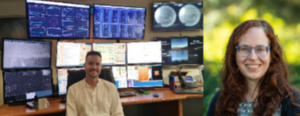Presented By: Department of Astronomy
Department of Astronomy 2023-2024 Colloquium Series Presents:
Dr. Vital Gutierrez Fernandez and Dr. Rachael Roettenbacher Post Doc Colloquium

Vital’s Title: Applying Machine Learning models in the analysis of large and complex spectroscopic data sets
Thanks to advancements in instrument design, upcoming sky surveys will generate as much data per day as the complete observations from completed surveys. Moreover, in the case of spectroscopy data sets, the increase in both wavelength range and instrument resolution will elevate the complexity of analyzing these observations to unprecedented levels. Consequently, existing algorithms must diversify their measurements while reducing the demands for both astronomer and computer time. In this presentation, I present my recent work on Green Peas galaxies. These are compact objects whose luminosity is dominated by a low metallicity star-forming burst. To improve the chemodynamic analysis of these objects, we have developed LiMe, a feature rich LIne MEasuring package (https://lime-stable.readthedocs.io/). Additionally, we demonstrate how this library can be employed to create your own online repository for sharing spectroscopic measurements, as we have done with the CEERs field JWST observations, spanning a 0 < z <10 range. Lastly, we discuss our future plans at University of Michigan, to leverage Machine Learning techniques to address the challenges posed by Astronomy Big Data.
Rachael’s Title: Starspots and the Search for Exoplanets
One way that the stellar magnetism of convective-envelope stars manifests is as starspots, which are localized regions of stifled convection. These cool surface features can affect the measurements of a star's fundamental stellar parameters, including radius and temperature, which ultimately lead to inaccurate estimates of mass and age. Starspots also can mimic or obscure the detections of exoplanets. As a result, an improved understanding of stellar surfaces is needed to be able to detect Earth-like planets around quiet Sun-like stars. My current work aims to use images of stellar surfaces to help disentangle the signatures of stars and their exoplanets. I will discuss the imaging techniques I use and my on-going project to image some of the closest Sun-like stars with sub-milliarcsecond resolution interferometric data. These surface images are used to model radial velocities for comparison with contemporaneous extreme precision radial velocity observations to improve our understanding of how stellar magnetism impacts the evidence and characterization of companions.
Thanks to advancements in instrument design, upcoming sky surveys will generate as much data per day as the complete observations from completed surveys. Moreover, in the case of spectroscopy data sets, the increase in both wavelength range and instrument resolution will elevate the complexity of analyzing these observations to unprecedented levels. Consequently, existing algorithms must diversify their measurements while reducing the demands for both astronomer and computer time. In this presentation, I present my recent work on Green Peas galaxies. These are compact objects whose luminosity is dominated by a low metallicity star-forming burst. To improve the chemodynamic analysis of these objects, we have developed LiMe, a feature rich LIne MEasuring package (https://lime-stable.readthedocs.io/). Additionally, we demonstrate how this library can be employed to create your own online repository for sharing spectroscopic measurements, as we have done with the CEERs field JWST observations, spanning a 0 < z <10 range. Lastly, we discuss our future plans at University of Michigan, to leverage Machine Learning techniques to address the challenges posed by Astronomy Big Data.
Rachael’s Title: Starspots and the Search for Exoplanets
One way that the stellar magnetism of convective-envelope stars manifests is as starspots, which are localized regions of stifled convection. These cool surface features can affect the measurements of a star's fundamental stellar parameters, including radius and temperature, which ultimately lead to inaccurate estimates of mass and age. Starspots also can mimic or obscure the detections of exoplanets. As a result, an improved understanding of stellar surfaces is needed to be able to detect Earth-like planets around quiet Sun-like stars. My current work aims to use images of stellar surfaces to help disentangle the signatures of stars and their exoplanets. I will discuss the imaging techniques I use and my on-going project to image some of the closest Sun-like stars with sub-milliarcsecond resolution interferometric data. These surface images are used to model radial velocities for comparison with contemporaneous extreme precision radial velocity observations to improve our understanding of how stellar magnetism impacts the evidence and characterization of companions.